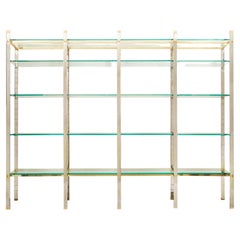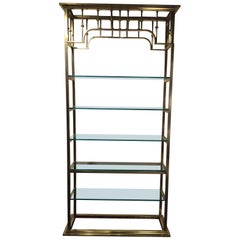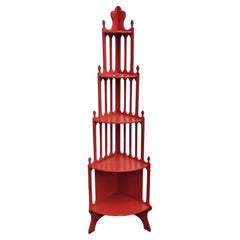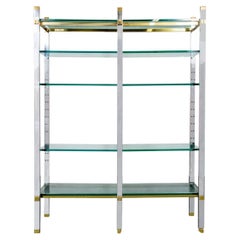Karl Springer Shelves
The Berlin-born, New York–based designer Karl Springer brought a chic, high-fashion sensibility to his coffee tables, mirrors, Lucite lamps and other furnishings. During his heyday in the 1970s, Springer’s work was a favorite of the glamour set, who enjoyed the novelty of pieces finished in rich and striking materials that ranged from exotic hides and skins to lacquer and chromed metal.
In a sense, Springer was a pre-postmodernist. Much as the dull, safe, corporate sameness of late 20th-century modernism prompted Ettore Sottsass, Michael Graves and others to explore new and provocative structures and materials in design and architecture, so, too, was Springer driven to enliven his creations with fresh and alluring energy and sleekness.
Springer came to New York in the late 1950s and found work arranging window displays at the department store Lord & Taylor. He had studied bookbinding in Germany, and, using his meticulous skills, he began crafting desk accessories wrapped in leather as a sideline. These pieces were sold in luxury stores like Bergdorf Goodman and drew a sophisticated clientele that included the Duchess of Windsor.
By 1965, Springer had established his own Manhattan atelier. It was Pierre Scapula, decorator to Jackie and Aristotle Onassis, who spotted Springer's disco-era Onassis chairs — which didn't yet have a name — first commissioned for a private residence in Acapulco, on the floor of the designer’s East 61st Street showroom. Jackie ordered barstools for the couple’s yacht, the Christina O, and dining chairs for their house on the Greek mainland.
At the time of his death, Springer had showrooms as far afield as Los Angeles, Tokyo and Munich.
The chairs, tables, credenzas and other furniture forms Springer created are generally simple, but substantial, and often have robust, rounded lines. The appeal of his work lies in Springer's insistence on exacting construction and, above all, his eye for unusual materials and finishes.
Springer employed Lucite, brass, and gunmetal along with chromed and polished steel, and revived exquisite finishes rarely seen since the days of Art Deco masters such as Émile-Jacques Ruhlmann and Jean-Michel Frank: shagreen (a type of sharkskin), python, goatskin, bone, horn, and lacquered parchment, as well as fabrics that include batik prints. Made of such materials, Springer’s work is by its very nature flamboyant and eye-catching: a suite of pieces will astonish, and an artfully placed side table in exotic hide will add a surprising spark.
Find a collection of vintage Karl Springer furniture today on 1stDibs.
20th Century Karl Springer Shelves
Brass, Nickel
1960s American Vintage Karl Springer Shelves
Brass
Mid-20th Century American Chinese Chippendale Karl Springer Shelves
Wood, Paint, Lacquer
Late 20th Century American British Colonial Karl Springer Shelves
Grasscloth, Faux Bamboo, Glass
1980s American Hollywood Regency Vintage Karl Springer Shelves
Brass, Iron
1970s Vintage Karl Springer Shelves
Chrome
1970s Mid-Century Modern Vintage Karl Springer Shelves
Chrome
1960s Directoire Vintage Karl Springer Shelves
Mahogany
19th Century English Chinoiserie Antique Karl Springer Shelves
Bamboo
20th Century Neoclassical Karl Springer Shelves
Iron
Mid-20th Century American Mid-Century Modern Karl Springer Shelves
Steel
Mid-20th Century Unknown Karl Springer Shelves
Rattan
1970s American Mid-Century Modern Vintage Karl Springer Shelves
Chrome
Late 20th Century Modern Karl Springer Shelves
Chrome
1970s American Mid-Century Modern Vintage Karl Springer Shelves
Stainless Steel
1980s American Mid-Century Modern Vintage Karl Springer Shelves
Brass
1970s American Vintage Karl Springer Shelves
1970s American Mid-Century Modern Vintage Karl Springer Shelves
Late 20th Century American Karl Springer Shelves
Mirror, Wood




